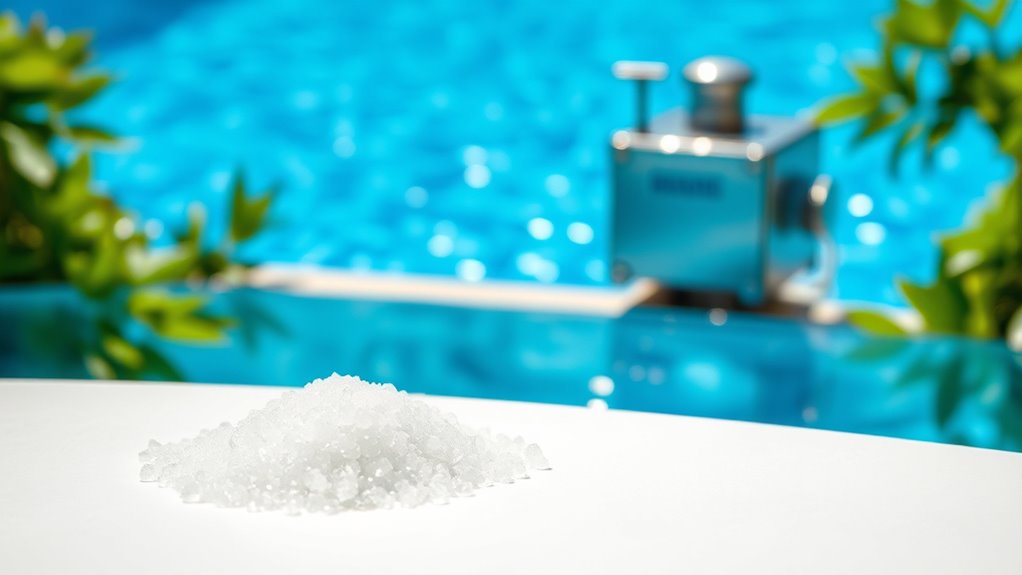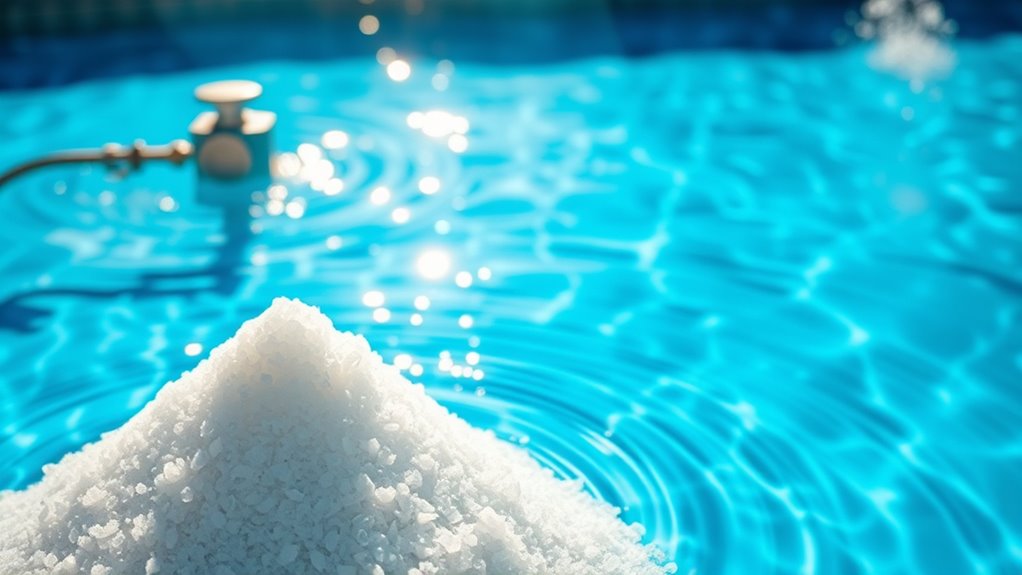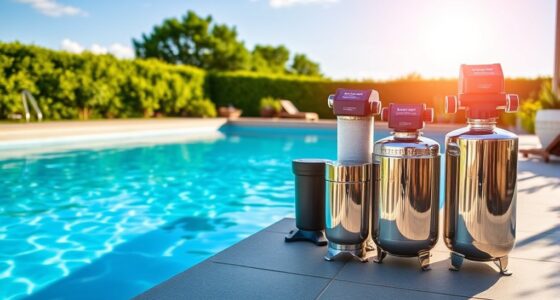Pool salt is essential for chlorination in saltwater pools. When salt (sodium chloride) dissolves in water, it separates into sodium and chloride ions. The chlorination system uses electrolysis, oxidizing chloride ions to produce chlorine gas, which then forms hypochlorous acid to sanitize the water. This process means less manual chlorine addition and a more enjoyable swimming experience. If you want to know about maintenance and benefits, there’s more to uncover.
Key Takeaways
- Saltwater pools use electrolysis to convert dissolved salt into chlorine, essential for pool sanitization.
- Sodium chloride splits into sodium and chloride ions, with chloride oxidizing to produce chlorine gas.
- Chlorine gas reacts with water to form hypochlorous acid and hypochlorite ions, which disinfect the pool.
- Continuous chlorine generation from salt reduces the need for manual chemical additions, enhancing convenience.
- Maintaining proper salinity and balancing chemical levels is crucial for effective chlorination and pool health.

When you choose a saltwater pool, you’re opting for a more efficient and comfortable swimming experience. The process of chlorination in these pools relies on the electrolysis of salt, turning it into chlorine. This system utilizes the natural properties of salt (sodium chloride), which, when dissolved in water, separates into sodium and chloride ions.
Choosing a saltwater pool enhances your swimming experience with efficient chlorination and comfortable, softer water.
As chloride ions pass through the electrolytic cell, they get oxidized at the anode, producing chlorine gas. This gas then dissolves in the water, forming hypochlorous acid and hypochlorite ions—active sanitizers that effectively eliminate bacteria and algae.
One of the significant advantages of salt chlorination systems is their automation. They continuously generate chlorine, creating a self-sustaining environment that reduces the need for manual chlorine additions. This feature not only saves you time but also lowers maintenance efforts, making it easier for you to enjoy your pool.
You’ll find that saltwater pools offer softer water, which means less skin irritation and no harsh chemical odors often associated with traditional chlorine pools. This comfort enhances your overall swimming experience, allowing you to relax and enjoy the water.
In terms of long-term cost-effectiveness, salt chlorination systems shine. While the initial setup may cost more than a traditional pool, the ongoing savings in chemical purchases often outweigh these costs.
Regular maintenance is still necessary, particularly in managing calcium buildup in the electrolytic cell. Keeping this cell clean is vital for maintaining effectiveness in chlorine production. Some advanced systems even employ reverse-polarity designs that minimize calcium scaling by alternating the roles of the electrodes.
Managing the salinity of your pool is also important. You’ll need to monitor salt levels and balance them by occasionally draining and diluting the pool water.
Additionally, pH levels can rise due to chlorine generation, so you might’ve to use CO2 or hydrochloric acid to keep things in check. Regular inspections of the system guarantee everything operates smoothly, maintaining ideal chlorination.
Frequently Asked Questions
Can I Use Regular Table Salt Instead of Pool Salt?
You shouldn’t use regular table salt instead of pool salt.
Table salt often contains additives like iodine and anti-clumping agents that can contaminate your pool water and damage equipment. Its lower purity level also affects chlorination efficiency.
While table salt might seem cheaper, investing in pool salt guarantees your system works effectively and lasts longer.
Stick to pool salt to keep your water clean and your chlorination systems running smoothly.
How Does Pool Salt Affect Water Chemistry?
Pool salt greatly impacts water chemistry in your swimming pool. When dissolved, it contributes to the salinity levels, which can influence pH and alkalinity.
You’ll need to monitor these parameters regularly, as imbalances can lead to scaling or corrosion. Additionally, salt helps stabilize chlorine levels, enhancing disinfection while reducing harsh odors.
Is Pool Salt Safe for Skin and Eyes?
Imagine you’re diving into a serene ocean, where the gentle saltwater caresses your skin and eyes.
When you swim in a saltwater pool, you’re enjoying similar benefits. The reduced harsh chemicals mean less irritation for your skin and eyes.
You’ll find lower chlorine levels, leading to fewer stings and discomfort.
Just remember, while saltwater’s gentler, individual sensitivities can vary, so it’s wise to be mindful of your body’s responses.
How Often Should I Add Salt to My Pool?
You should add salt to your pool when necessary, typically after significant water changes, like after backwashing or heavy rainfall.
Regularly testing your salt levels helps identify when they’re low. Aim for a salt concentration between 3200 and 3400 ppm for peak performance.
If levels drop below this range, you’ll need to replenish the salt to maintain effective chlorine generation and keep your pool water healthy and clear.
Can I Swim Immediately After Adding Pool Salt?
You might worry that swimming right after adding pool salt isn’t safe, but it generally is!
As long as your salt levels are correct and the chlorinator’s working, you can plunge in shortly after. Just make sure the water’s circulating well and the salt concentration meets the recommended range.
Enjoy the softer water and reduced irritation while you swim, knowing you’re maintaining a healthier pool environment for yourself and your guests.
Conclusion
In conclusion, pool salt plays a crucial role in keeping your swimming oasis sparkling clean and safe. By turning salt into chlorine, it’s like a magician transforming ordinary water into a rejuvenating haven. With regular checks and proper maintenance, you can guarantee your pool remains a safe retreat for family and friends. So plunge in and enjoy the crystal-clear waters, knowing that salt’s got your back in the fight against unwanted bacteria!









